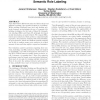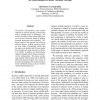153 search results - page 2 / 31 » Better Informed Training of Latent Syntactic Features |
KDD
2009
ACM
14 years 6 months ago
2009
ACM
Address standardization is a very challenging task in data cleansing. To provide better customer relationship management and business intelligence for customer-oriented cooperates...
KCAP
2011
ACM
12 years 8 months ago
2011
ACM
Open Information Extraction extracts relations from text without requiring a pre-specified domain or vocabulary. While existing techniques have used only shallow syntactic featur...
BMCBI
2008
13 years 5 months ago
2008
Background: Protein remote homology detection and fold recognition are central problems in bioinformatics. Currently, discriminative methods based on support vector machine (SVM) ...
EMNLP
2008
13 years 7 months ago
2008
We present a discriminative, latent variable approach to syntactic parsing in which rules exist at multiple scales of refinement. The model is formally a latent variable CRF gramm...
ACL
2008
13 years 7 months ago
2008
Parse-tree paths are commonly used to incorporate information from syntactic parses into NLP systems. These systems typically treat the paths as atomic (or nearly atomic) features...


